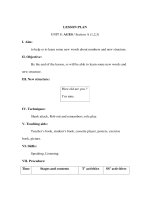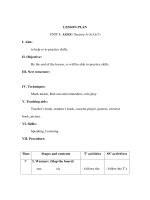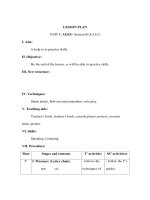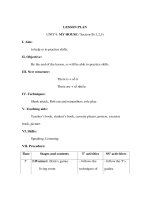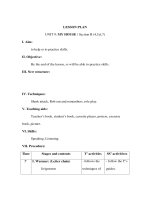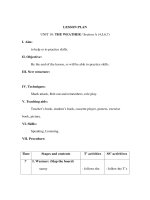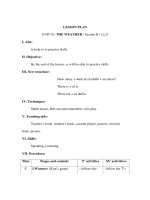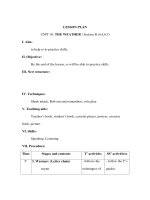giáo án tiếng anh lớp 6
Bạn đang xem bản rút gọn của tài liệu. Xem và tải ngay bản đầy đủ của tài liệu tại đây (1.49 MB, 157 trang )
Gi¸o ¸n Anh 6 2014-2015
ENGLISH 6
Date of preparing: 22/ 8/ 2014
Date of teaching: 25/ 8/ 201(6AC),27/8(6B)
UNIT 1: MY NEW SCHOOL
Period 1
Lesson 1 : Getting started
I.Ojectives:By the end of this Unit , students can :
1. Pronounce correctly the sounds and in issolation and in context
2. Use the lexical items related to the topic “My New School”
3. Use the simple present and the present continuous
4. Talk about school activitives, subjects, and what students do at school
5. Listen and read the conversation and take turn to make a new conversation
II.Main languages
-Words related to the school.
- The expressions : Oh dear ; you’ll see ; come in ; sure
- Present continuous tense
- Structures: look + adj ; the same… as
III. Teaching aids
Teaching plan ,computer
IV. Procedures
* Management
* Checking the old lesson
* New lesson
Teacher and students’activities
1. Warm up
- Ask students to introduce some information about
themselves
- Students listen to their friends and retell the
information to the teacher and the classmates
- Teacher : remark
2. Presentation
Ask students to look at the screen and observe the
picture ( in the book ) and answer some questions
T: Where are they ? Are they at school ?
Content
1
NguyÔn Sinh Phóc THCS Duy H¶i
Gi¸o ¸n Anh 6 2014-2015
Who are Vy and Duy? Or Are Vy and Duy
Phong’s friends?
What are they going to do?
And why is today a special day ?
+Teacher introduce some new words by using picture
on the slide
+ T: introduce the structures “ look + adj” and “the
same + n + sub” and have the students to give
examples
- Ask students to guess their conversation
- Have the students open their books and listen to the
tape
T: play the tape and students listen and read
3. Practice
After listening , teacher asks students to read in silence(
in pairs) and call some pairs to play the role to read
before class
- Have students read the conversation again in silence
and do exercise 1a in the book
- T: ask students to look at the slice ( 1a) and read the
order
T: What do you do with this exercise ?
S: answer and do it in groups ( each group has 4 sts)
- Call the groups to write the answer on the board
- Ask the groups to remark
- T remarks and gives the correct answers
- Call some students to read the sentences and
correct the false sentences
- T: ask sts to read the conversation again and check the
meaning of these expressions
T: give some questions to help sts guess the meaning
easily
T: Who says “ oh dear” ? Does she go to school early ?
Why is she early? “ oh dear” in the situation is used to
express surprise ( nagetive)
- T: explain the meaning to the sts and then give some
examples
- Do the same with 2, 3, 4
- Sts practise saying them together
-Ask sts to role- play the short conversations in pairs
before creating short role-plays( more able sts can try
1.Vocabulary
- calculator(n)
- smart(a)
- uniform(n)
- wear(v)
- put on (v)
-knock(v)
2. structures
- Look+ adj
Ex: she looks nice
His schoolbag looks heavy
- the same … as ….
Ex: I go to the same school as you
She teaches E at the same school as me
Exercise 1a: T or F?
1.Vy and Duy are early
2. Phong is eating
3. Duy is phong’s friend
4. Duy lives near Phong
5. Phong is wearing a school uniform
Key
1. T 2. T 3. F
4. T 5. F
Exercise 1b
1. Oh dear
2. You’ll see
3. Come in
4. Sure
Key:
2
NguyÔn Sinh Phóc THCS Duy H¶i
Gi¸o ¸n Anh 6 2014-2015
to extend the conversation )
- T: guide sts to extend the conversation
T: Can you open the door for me ?
St : Sure.
St1: Phong has a new school bag
St2: It looks nice – you see
-T: ask sts to look at the poem in the book
-T: Play the recording . Let’s the whole class read the
poem with the right intonation and rhythm. Ask
questions to check sts’ understanding of the poem.
Then sts work in pairs and write the poem about the
partner, then read the poem aloud
-T: have sts observe things on the picture on the sceen
(slide)
- Ask sts to name the thing they see
- T: Give the words in the book and ask sts to compare
the words they find with the words in the book
T: Ask sts to match the words with the school things
T: play the recording and then let them practise saying
the names of the school things
-Ask sts to write the correct words in the spaces. Allow
sts to check their answers ( in pairs)
-T: ask sts to read the words in ex 3 again and draw a
picture next to new words in the vocabary book
- T: Draw a ruler on the board and ask sts to look
around the classroom : table, desks, notebooks,
noticeboard, picture,
- Sts can draw the things in the classroom and write the
words next to the picture
- Let them practise the words, and make up sentences
with the words they draw
4. Consolidation
- call some sts to reads all the new words again
- Call 2 pairs to read the conversation again and find
some sentences using the present continuos tense
- Ask sts to make up some sentences using the present
continuous tense and the words in this lesson
Ex: I am using a caculator
She is riding a bicycle
Oh dear, you are wearing a beautiful skirt
5. Homework
1 . express surprise
2. you’ll see = you’ll find out
3. invite sb in
4. = yes/ all right
Exercise 1c
A: Oh dear. I forgot caculator.
B: That’s OK, you can borrow mine.
A: Thank you
Exercise 2: Listen and read the poem.
Example:
Khanh is going back to school today.
His friends are going back to school, too
His new school year starts today.
He’s got a new school bag
………………………………
Exercise 3:
1-b: pencil sharpener
2-e : compass
3-j : school bag
4-d : rubber
5-c: calculator
6-i : pencil case
7- f: notebook
8- a : bicycle
9- g: ruler
10- h : textbook
Exercise 4: Learning tips
ruler
3
NguyÔn Sinh Phóc THCS Duy H¶i
Gi¸o ¸n Anh 6 2014-2015
- Learn by heart all the new words
- Make up 10 sentences with the new words
- Prepare the next lesson : A closer look 1
Someone is knocking at the door .
Phong is having breakfast
You are wearing the uniform, Duy
Date:
Remark:
Date of preparing: 23/8/2014
Date of teaching: 26/8(6AC),29/8(6B)
UNIT 1: MY NEW SCHOOL
Period 2
Lesson 2: A closer look 1
I.Objectives: By the end of the lesson, sts can :
- Pronounce correctly the sounds and in isolation and in context
- Use the combinations: to study, to have, to do , to play
- Help sts listen better
II.Main languages.
- Words related to the subjects , study
- Some verbs : play ; do ; have ; study and Nouns go with these verbs
- Pronunciation : the sounds : /əʊ / / ʌ /
- Present simple tense and present continuous
III. Teaching aids
Teaching plan , projector, …
IV. Procedures
* Management
* Checking the old lesson
4
NguyÔn Sinh Phóc THCS Duy H¶i
Gi¸o ¸n Anh 6 2014-2015
* New lesson
Teacher and students’activities
1.Warm up
- T: have sts play a game : Match the words with the
picture
- Divide the class into 4 groups
- T: guide sts how to play this game
- Ask sts to work in groups
- Call each group to write the answer on the board
- Have the groups remark each other
- T: Remark and decide which group wins the game
2. Presentation
T: Through “warm up” T ask sts to look at the screen (
Vocabulary 1)
- Ask sts to have a look at the words and then T plays
the recording and let sts listen once
- T: play it again and pause for sts to repeat each word.
Correct their pronunciation.
- T: ask sts to make up some sentences with the new
words
3. Practice
- T: Have sts observe the activities in the picture ( on
slide )
- Ask sts to name the activity ( Play the badminton)
- T: Which words can go with the verb play?
St: answer ( tennis , football, the piano….)
T: Ask sts to do exercise 2 : Let sts work in pairs,
Putting the words in ex 1 into groups.
- Call some sts to read the words which go with each
verb
- T: check the answers . Explain to them which words
go with each verb
- T : Encourage sts to add more nouns to the groups
- Ask sts to read the phrase in part 2 again and then tell
sts to do ex 3 individually . Call some sts to write on
the board, then check their answers
- Call sts to read the sentences aloud
\
- Ask sts to write sentences about themselves in their
notebooks, using the combinations above. They can
write as many sentences as possible.
Content
1, physics
2. football
3. judo
4. history
5. school lunch
6. homework
Vocabulary
1.Listen and repeat the words
- Physics - Exercises
- English - vocabulary
- History - lessons
- Homework - music
- Judo - football
- School lunch - science
2.Put the words in the groups
Play : football, music
Do: homework, judo, exercise,
Have: school lunch, lessons,
Study: Physics, English, History, vocabulary,
science
3.Put one of these words in each blank
5
NguyÔn Sinh Phóc THCS Duy H¶i
Gi¸o ¸n Anh 6 2014-2015
T: Write the words : judo and Monday .
- Call sts to read the words and tell the pronunciation
the letter “o”
- Ask sts to observe the T’s lip positions for these two
sounds.
- Let sts practise the sound /ə ʊ / and /ʌ/ together.
- Play the recording and ask sts to listen and repeat
( play as many time as necessary
- Ask sts to give more words that pronounce /ə ʊ /
/ʌ/
- Ask sts to have a look at the words in part 6 and read
the words aloud
- T: Play the recording twice . Allow sts to work
individually . Them let them check their answer in
groups.
- T : Call some sts to write the words into two groups
on the board
- Call sts to remark and then T corrects them
- Play the recording again and check the answers
- Have sts read the sentences in part 7 and then
recognize the words that pronounce /ə ʊ / /ʌ/
-T: play the recording . Let sts repeat sentence by
sentence. Help them check the sound they themselves
pronounce.
- Ask sts to underline them in the sentences
- Call some sts to read the words aloud
4. Consolidation
- Ask sts to read the phrases verbs in part 2 again and
make up some sentences using the phrases verbs
- Ask sts to repeat the two sounds /ə ʊ / /ʌ/ and then
read all the words in part 6
5. Homework
- Ask sts to make 5 sentences using the verbs in part 3
- Add more words that pronounce /ə ʊ / /ʌ/
1. homework
2. football
3. lessons
4. judo
5. science
4. Write sentences ….
Ex: I have English lessons on Tuesday and
Thursday
………………………….
Pronunciation
5. /ə ʊ / / ʌ /
1. /əʊ / : judo, going, homework, open,
2. /ʌ/ : brother, Monday , mother , month
6.Listen to the words and put them into two
groups
/əʊ / : rode, don’t, hope, homework, post.
/ʌ/: some, Monday, month, come, one
7.Listen and repeat .
1. They are going to open a new library
2. I’m coming home from school
3. His brother eats lunch in the school canteen
4. The new school year starts next month
5. My brother is doing his homework
6. He goes to the judo club every Sunday
6
NguyÔn Sinh Phóc THCS Duy H¶i
Gi¸o ¸n Anh 6 2014-2015
- Prepare the next lesson : A closer look 2
Date:
Remark:
Date of preparing: 23/8/2014
Date of teaching:27/8(6A),29/8(6C),30/8(6B)
UNIT 1: MY NEW SCHOOL
Period 3
Lesson 3: A closer look 2
I.Objectives: By the end of the lesson , sts can :
- Use the present simple and present continuous.
- Read for specific information about email and wedpage
- Practise making up sentences using present simple and present continuous
II. Main languages
- Pesent simple and present continuous
- Words related the things at school.
III. Teaching aids
- Teaching plan , projector , handout for sts
IV. Procedures
* Management
* Checking the old lesson
* New lesson
7
NguyÔn Sinh Phóc THCS Duy H¶i
Gi¸o ¸n Anh 6 2014-2015
8
NguyÔn Sinh Phóc THCS Duy H¶i
Teacher and students’activities
1.Warm up
- Have sts play a game : Look at the picture and
make up as many sentences as possible
- Ask sts to work in groups and then T calls groups to
present their examples before class.
- Call sts to remark and T remarks and decides which
group wins the game
2.Presentation
- Ask sts to tell which tense is used in sentence 1,3.
Sts: present simple
-T: Can you tell me the form of it ?
( Say the form of positive, negative and question and
short answers)
S: Say the form of it.
- Repeat the use and form of the present simple
tense and its note.
- Ask sts to give some examples using present
simple.
- Ast sts to read the sentence 3,4 and tell the tense of
them .
S: present continuous
T: Can you tell the use and the form of it?
T: Notice some special cases.
Ex: Put – Putting : write – writing
Lie - lying
- Ask sts give some examples ( positive. Negative
and question)
3.Practice.
Exercise 1: Write the correct form of the verbs.
T: What do you do with the exercise?
- Ask sts to read the conversation do the ex.
- Let sts do the task individually.
- Call sts to write their answers on the board .
- Have sts correct first and then T corrects their answers
( T asks sts to explain their answers)
Exercise 2: Role- play the interview.
- Let sts to role – play the interview. T observes and
helps sts when and where necessary ( correct sts’
pronunciation and verb form)
Exercise 3: Find out and correct the mistakes.
-Ask sts to read the sentences in ex 3.
- Allow sts to write the sentences in their notebooks
Content
Ex: 1.They often play badminton after school.
2.They are playing badmimton now.
3. He does his homework in the evening .
4.He is doing the homework at the moment.
……………………………
The present simple
Positive
I/ You/ We / They / N( P) + V(in-f)…….
He / She / It / N (s) + V-s/es
Negative
I / You / We/ They/ + don’t + V( in-f)…
Question
He/ She / It + doesn’t + V…
Do/ does + S + V……?
He likes English
She doesn’t like football
Do they have E on Monday?
Present continuous.
Positive
S+ be + V-ing………
Negative
S + Be + not + V-ing
Question
Be + S + V-ing?
Ex 1:
Key :
1. has 2. Do you have
3. love 4. Does Vy walk
5. ride 6. teaches
7. doesn’t play 8. reads
9. go 10. do
Ex 3:
Key:
1. Duy lives near here.
2. Duy likes his new school.
3. Vy and Duy ride to school.
4. Mr Quang teaches Duy English.
Gi¸o ¸n Anh 6 2014-2015
Date:
Remark:
Date of preparing: 29/ 8/ 2014
Date of teaching:1/9(6AC),3/9(6B)
UNIT 1: MY NEW SCHOOl
Period 4
Lesson 4 : Communication
I. Objectives.
- Use the lexical items related to the topic “ My new school”.
- Ask appropriate questions when making new friends at a new school.
- Help sts to communicate with others in English.
II. Main languages.
- Vocabulary: pocket money, remember, share, help, classmate, friendly, helpful, generous,
cheerful……………
- Grammar & structures : Present simple, help sb with ……
III. Teaching aids:
- Teaching plan, projector, handout……
IV. Procedures
* Management
* Checking the old lesson
* New lesson.
9
NguyÔn Sinh Phóc THCS Duy H¶i
Gi¸o ¸n Anh 6 2014-2015
10
NguyÔn Sinh Phóc THCS Duy H¶i
Teacher and students’activities
1.Warm up.
+ Have sts play a game. Look at the picture and answer
the teacher’s questions.
+ T: guide sts how to play the game.
+ T: Devide the class into 2 groups . T: Read the
question and which group raise the hand first , that
group will answer first .
- If they have the correct answer , they will get 5 points.
- Which group has more points will win the game.
+ T: Give 6 pictures and make up 6 questions.
1. What is the boy doing?
2. What subject do they have today?
3. Do they have dinner at school?
4. Is he a musician?
5. What are they doing?
6. Do you like playing badminton?
T: Are the activities at school?
S: No, they aren’t
2. Presentation
- Chatting :
T: Do you remember Duy ?
+ Is he Phong’s friend?
+ Does Duy live near Phong?
+ Did he live here before?
T: Duy is new here and he is a new student at Phong’s
school.
T: Imagine you are Duy’s classmates , what will you ask
Duy ?
- Where are you from?
- Do you learn English at school?
- Do you like music?
- What is your favorite subject at school?
- What is your favorite food?
- Do you play football?
- How do you go to school?
3.Practice.
- Have sts to look at the vocabulary. And guess the
meaning of them.
- Tell sts that this vo. will appear in the tasks that
follow.
- T: explains the new words
+ pocket money: A small amount of money that parents
give children , usually every week or every month.
+ Share : have or use st at the same time as your friends
+ Classmate: A person who is or was in the same class
as you at school.
+ remember: to have or to keep an image in your
memory o a person , a place from the past.
- Ask sts to make up some examples using the new
words.
T: Play the slide with the questions in the textbook. (1.
Game)
- Have sts read all the questions .
T: Asks sts how they often make friends, what they
often say when they first meet a new friend, what
questions they often ask.
Content
- Where are you from?
- Do you learn English at school?
- Do you like music?
- What is your favorite subject at school?
- What is your favorite food?
- Do you play football?
- How do you go to school?
1.Game: Making friends.
Read and tick the questions you think are
suitable to ask a new friend at school .
+ Vocabulary:
- pocket money (n)
- remember(v)
- share(v).
- classmate(n)
Gi¸o ¸n Anh 6 2014-2015
Date of preparing: 1/9/2014
Date of teaching: 6c 8/9
UNIT 1: MY NEW SCHOOl
Period 5
Lesson 5: Skills 1
I.Objectives
- By the end of the lesson, sts can :
+ Use the lexical items related to the topic “ my new school”
+ Use the present simple and present continuous
11
NguyÔn Sinh Phóc THCS Duy H¶i
Gi¸o ¸n Anh 6 2014-2015
+ Read for specific information about schoolsand read e-mail and web pages.
+ Talk about school activities, subject and what sts do at school.
II. Main languages.
- Vocabulary: boarding school, oversea, surround, equipment, join, creative,…
- Grammar: Present simple.
III. Teaching aids:
- Teaching plan, book and exercise book,…….
IV. Procedures
* Management
* Checking the old lesson
* New lesson.
Teacher and students’activities
1.Warm up
-T: give a picture of a school and ask sts to
describe it .
- Have sts to work in groups and give out the
description of the school.
- Call on some sts to present before the class.
- T: Remark and give some ideas about the school
2. Presentation.
- T: Show the picture of PLC Syney and ask sts to
observe and then tell the class some information about
the school.
- T: Explain the word “boarding school”
- T: Guide sts to get information from the passage :
+ Sts’study.
+ Subjects at this school.
+ Who can learn at this school?
+ What sts do at school?
T: Explain some new words
- Show the picture about a school in the montainous
area.
- Ask sts to observe the picture and tell some
information about the school.
- T: Guide sts to get information from the passage.
+ How many classes?
+ How many sts?
Content
- The school is in the country.
- It is big.
- It has many classrooms.
- The sts here wear uniforms.
- There is a library, a school garden, a computer
room, an English – learning room……
- Boarding school: Sts study and live at school .
They only go home on weekends.
- oversea: using a picture about other countries
- Kindergarten: Picture on screen.
- 7 classes
- 194 sts
- Near the mountains and green fields.
- A computer room.
- A playground.
- Small.
12
NguyÔn Sinh Phóc THCS Duy H¶i
Gi¸o ¸n Anh 6 2014-2015
+ Where is it?
+ What are there in the school?
+ How is the school?
- T: Show some pictures in order to introduce some
information about the school.
+ Bid buildings
+ modern equipment
+many interesting clubs: sports, art club……
T: introduce some new words through the pictures.
3. Practice.
A. Activity 1:
- Tell the sts to read the three passages quickly and
check their ideas. Set a strict time limit to ensure sts
read quickly for information.
B. Activity 2:
- Ask sts to read the passages again. Then find the
words in the passages . Help them to give the meaning
of the words, or explanations,or examples, Vnese
equivalen. Tell them to pay attention to the context od
the words.
T: Ask sts to find out the sentence in the passages
using these words- It is a boarding school.
- The school is surrounded by mountains and green
fields
- ……………….
Activity 3:
- Set a longer time limit for sts to reread the text and
find the words to finish the sentences, ask sts to note
where they found the information that helped them
complete the sentences , sts can compare the answers
before discussing them as a class.
- Allow sts to read in chorus once. Then call some
individuals to read aloud to the class. Check their
pronunciation and intonation.
SPEAKING
Activity 4:
- Ask sts to refer back to the three schools. Give some
background of the school. Which school ( among the
three above) would you like to go to ? Why?
- T: ask sts to speak about the school that they would
like to
- Allow sts time to answer the questions “go to.
- Sts complete the table in in their notebooks. Then
divide the class into groups of 4or 5, let them discuss
their answers to the questions, and give reasons. When
- equipment(n)
- join(v)
- creative(a)
Activity 2:
- boarding school: that means many sts study
and live there.
- surrounded: to be all around st or sb
- international: connected with two or more
countries
- creative: in Vnese
Activity 3:
Key:
1. boarding
2. Vinabrita
3. Australia
4. mountains
5. English speaking teacher
13
NguyÔn Sinh Phóc THCS Duy H¶i
Gi¸o ¸n Anh 6 2014-2015
they finish, ask some Sts to talk to the class, then the
class give their comments on their friends’ content,
pronunciation, fluency, language(grammar, use of
words…)body language, etc.
-Discuss any common errors and provide further
practice if necessary .
4. Consolidation .
- Ask sts to retell the three passages.
- Have sts read the new words again
- Ask sts to tell some information about their school.
5. Homework.
- Rewrite the information about the school.
- Preparation: Skills 2
Name of
the
school
Reasons
you like
it
Reasons
you don’t
like it
Remark:
……………………………………………………………………………………………………………………
……………………………………………………………………………………………………………………
……………………………………………………………………………………………………………………
………………………………
date:
Date of preparing: 1/9
Date of teaching: 6c 10/9
UNIT 1: MY NEW SCHOOL
Period 6
Lesson 6: Skills 2
I. Objectives.
- Consolidate the vocabulary , structures and grammar .
- Sts practise writing a webpage for a school, using correct punctuation.
- Listen to get information about school activities.
II. Main languages.
- Vocabulary: webpage, punctution, …….
- Grammar: Present simple
- Structures : some kinds of questions
III. Teaching aids
- Teaching plan , projector , handout for sts
IV. Procedures
* Management
* Checking the old lesson
* New lesson
.
14
NguyÔn Sinh Phóc THCS Duy H¶i
Gi¸o ¸n Anh 6 2014-2015
15
NguyÔn Sinh Phóc THCS Duy H¶i
Teacher and students’activities
1.Warm up
- T: Show a picture of a school and some pictures
showing the facilities of this school and ask sts to
describe it
-T: guide sts how to describe it
+ Where it is
+ How it looks
+ How it is
+ What there are in this school
+ How many sts and teachers
+ How many classes
2.Presentation
- T: Give a passage without commas
- Ask sts to read it and correct . Then add commas after
each sentence
T: Guide sts to have correct punctution.
- Capital letters for starting sentences, names , days and
months, The pronounce, and places.
- Pause and endings: commas to separate long sentences
and lists of things. Full stops, question marks, or
exclaimation marks are put at the end of the sentences.
- Ask sts to write commas in correct possition.
- T: remark and give the correct answer
- Tell the class the importance of punctution marks.
Allow some time for the sts to study the writing tip .
Explain to them the new words and punctution marks
3. Practice
- Ask sts to refer back to the reading PLCSydney. T
introduces Susie … is a student at PLC Sydney
- T: Play the recording. Ask sts to listen only the first
time. Then play the recording again and allow sts to
choose the correct answers as they listen
- Ask sts to share their answers
- Call on some sts to write their answers on the board.
- Play the recording again once more time to check the
answers.
Activity 2:
- Ask the sts to correct the punctuation in the
sentences in their notebooks. Then call 5 sts to
write the 5 sentences on the board. Let the class
comment and check. T finally gives correction.
Content
this is tung lam he is a student at quang trung
primary school the school held a sports day
yesterday all the teachers and students were
there the students played different sports and
games such as football badminton chess and
hide-and-seek tung lam played badminton very
well he was happy because he was the best
player.
This is Tung Lam. He is a student at Quang
Trung Primary School. The school held a
sports day yesterday. All the teachers and
students were there. The students played
different sports and games such as football,
badminton, chess, and hide-and-seek. Tung
Lam played badminton very well. He was
happy because he was the best player.
Activity 1:
Key
1. A
2. A
3. B
4. B
5. A
Activity 2:
Key
1.School starts on the 5
th
September .
Gi¸o ¸n Anh 6 2014-2015
Remark:
date:
Date of preparing: 1/9
Date of teaching: 6c 11/9
UNIT 1: MY NEW SCHOOL
Period 7
Lesson 7: Looking back and project
I. Objectives.
- By the end of this lesson, students can:
- Revew and drill section of the unit: the vocabulary , structures and grammar .
- Use the pictures and their imagination, then write about their dream school and illstrate their writing.
II. Main languages.
- Vocabulary
- Grammar: The present simple and the present continuos.
- Structures : some kinds of questions.
III. Teaching aids
- Teaching plan , projector , handout for sts
IV. Procedures
* Management
* Checking the old lesson
* New lesson
16
NguyÔn Sinh Phóc THCS Duy H¶i
Gi¸o ¸n Anh 6 2014-2015
17
NguyÔn Sinh Phóc THCS Duy H¶i
Teacher and students’activities
1.Warm up.
- Teacher gives some words and asks students to
oder in the correct column.
" physics, physics, do , play, calculator, watch, compass,
study, have, pencil shaperner, notebook "
Verbs Nouns
do
play
watch
study
have
physics
calculator
compass
pencil shaperner
notebook
2.Presentation
- Teacher tells Ss to write the words in their notebooks.
Then teacher corrects the mistakes.
- Let the repeat the words
- Check their pronunciation
3. Practice
- Have Ss write their answers in their notebooks.
- Teacher checks their answers.
- Teacher play the recording twice. Let Ss write the
words in the correct places
- Teacher gives correction.
- Students do Ex individually first.
- Students check their answers each other.
- Teacher checks and gives the correct answers.
- Students work individually
- Students check their answers each other.
- Teacher checks and gives the correct answers.
- Call some Ss to read before the class.
- Call some students write them on the board
- Teacher and students check and give the correct
answers
Content
* Vocabulary:
1. Write words that match the pictures
1. dictionary
2. uniform
3. pencil shaperner
4. notebook
5. compass
6. calculator
2. Match the words in A with the ones in B
1- b
2- c
3- a
4- d
3. Listen. Then write down the words you
hear in the correct places.
+ Play: sports, badminton, music
+ Do: morning exercise. homework.
+ Study: new words, geography
+ Have: English lessons, a new book
* Grammar:
4. Complete the sentences with the present
simple
1. comes
2. don't
3. walks
4. do
5. teaches
6. play
5. Complete the sentences with the present
continuous
1. are doing
2. are riding
3.Is studying ?
4. is having
5. am walking
6. is teaching.
6. Complete the text with the correct formof
the verbs in brackets.
1. lives
2. go
Gi¸o ¸n Anh 6 2014-2015
Remark:
……………………………………………………………………………………………………………………
……………………………………………………………………………………………………………………
……………………………………………………
date
Date of preparing: 8/9/2014
Date of teaching: 6c 17/9
UNIT 2: MY HOME
Period 8
Lesson 1: Getting started
I. Objectives.
By the end of this lesson, students can:
2. Use the lexical items related to the topic" My home".
3. Use prepositions of place correctly.
4 Listen and read infomation about rooms and houses.
II. Main languages.
- Vocabularies:
+
apartment, move, bedroom, kitchen, bathroom,
+ in front of, behind, between, under
- Strutures: There is / There are
III. Teaching aids
- Teaching plan , projector , handout for sts
IV. Procedures
* Management
* Checking the old lesson
* New lesson
18
NguyÔn Sinh Phóc THCS Duy H¶i
Gi¸o ¸n Anh 6 2014-2015
19
NguyÔn Sinh Phóc THCS Duy H¶i
Teacher and students’activities
1.Warm up.
- Techer asks students some questions:
+ Where do you live?
+ Is your house big?/ small?
+ Is it old or new?
- Teacher writes the unit title " My home" on the
board and explains .
+ " Home" can have diffirent meanings. It can be
the house or apartment where you live or can refer
to a family living together.
- Teacher asks students to look at the pictures and
introduces Mi and Nick
2. Presentation
Ask students to look at the screen and observe the
picture ( in the book ) and answer some questions
+ What are Nick and Mi doing?
+ Are they chatting ?
-Teacher introduces some new words by using picture
on the slide
- T: introduce the structures
+ “ there is / there are "
+ like + Ving
and have the students to give examples
- Ask students to guess their conversation
- Have the students open their books and listen to the
tape
T: play the tape and students listen and read
3.Practice
-Teacher asks students some questions in the part 1
+ Does Mi live in a town house?
+ Is it in the city center ?
+ Who does she live with?
+ Where does Nick live?
- After answering the questions, teacher asks students
to complete the table.
Content
1. New words.
- apartment (n)
- living room (n)
- bedroom (n)
- kitchen (n)
- bathroom (n)
- cousin (n)
- aunt (n)
- move (v)
- next to ( prep)
- behind (prep)
2. Structures:
*There is +a/ one/ an +
Eg:
There is a sofa in the living room
one television in the house
a picture on the wall.
* There are +
Eg:
There are three chairs in her living room.
two beds in my bedroom
ten books on the table
Exercise 1(a): Which family members does Mi
talk about?
Gi¸o ¸n Anh 6 2014-2015
Remark:
……………………………………………………………………………………………………………………
……………………………………………………………………………………………………………………
……………………………………………………………………………………………………………………
………………………………
date:
Date of preparing: 8/9/2014
Date of teaching: 6c 18/9
UNIT 2: MY HOME
Period 9
Lesson 2: A closer look 1
I. Objectives: By the end of this lesson, students can
1. Pronounce correctly the ending sounds /z/ , / s/ and /iz/
2. Use the lexical items related to the topic" My home".
3. Use the structure " There is / There are " correctly and oppropriately.
4. Listen and read infomation about rooms and houses.
II. Main languages.
- Vocabularies:
+
hall, attic, toilet, cupboard, chest of drawers, fridge, poster, air- conditioner
- Strutures: There is / There are
III. Teaching aids
- Teaching plan , projector , handout for sts
IV. Procedures
* Management
* Checking the old lesson
* New lesson
Teacher and students’activities
1.Warm up.
-Techer asks some questions:
+ Is your house big or small?
+ How many rooms are there? What are they?
2. Presentation
Content
20
NguyÔn Sinh Phóc THCS Duy H¶i
Gi¸o ¸n Anh 6 2014-2015
- Teacher explains new word by picture in
the part 1.
- Ask Ss to look at the picture and give the name
rooms of the house.
- Teacher checks the answers
3.Practice.
- Teacher explains new word by picture in the part
2.
- Students work in group ( 6 groups).
- Each group can write name the things in each room.
- Call some Ss in each group to check each other.
- Teacher remarks.
- Teacher plays the recording ( part 3)
- Ss listen and repeat the words
- Aks students more words for each group.
- Teacher asks students to work in pairs in this part.
+ Ss can choose the room which they like.
+ Call some pairs to practise in front of the class.
S1: What's in the room?
S2: A sofa and a television.
S1: Is it the living room?
S2: Yes.
1. Look at the house below. Name the rooms
of the house.
1. Vocabulary:
- hall (n)
- attic (n)
* Name the rooms of the house
a. living room
b. bedroom
c. attic
d. bathroom
e. kitchen
f. hall.
2. Name the things in each room in 1 . Use
the word list below.
- toilel (n)
- cupboard (n)
- chest of drawers (n)
- fridge (n)
- poster (n)
- air- conditioner (n)
- wardobe (n)
- dishwasher (n)
- microwave (n)
- ceiling fan (n)
* Name the things in each room.
+ Living room: lamp, sofa, picture, table.
+ Bedroom: bed, lamp, picture, chest of
drawers.
+ Kitchen: fridge, cupboard, cooker, table,
dishwasher, chair.
+ Bathroom: bath, sink, toilet
+ Hall: picture.
3. Listen and repeat the words.
4. Ask and answer the questions to guess the
room
21
NguyÔn Sinh Phóc THCS Duy H¶i
Gi¸o ¸n Anh 6 2014-2015
- Have some Ss read out the words first.
- Play the recoding for them to listen and repeat the
words.
- Ask sts to have a look at the words in part 5 again and
read the words aloud
- T: Play the recording twice . Allow sts to work
individually . Them let them check their answer in
groups.
- T : Call some sts to write the words into three groups
on the board
- Call sts to remark and then T corrects them
- Play the recording again and check the answers
- Teacher explains the way to pronounce - s/ es at the
end of the words.
- Explain the rules:
/ z/
Final - s is pronouunced / z/ after voiced sounds /
b/, / d/ , /g/, /m/, /n/ and any vowel sounds.
Eg: beds, dogs, cans, rooms, videos, cookers,
/s/
Final - s is pronounced / s/ after voiceless sounds ( /
p/, / t/ , /k/, /f/, /θ/ )
Eg: cats, lamps, books, months,
/ iz/
Final -es is pronounced /iz/ after /s/, /z/, /∫/,/t∫/,/dʒ/.
Eg: buses, huoses, watches. pages
- Have sts read the sentences in part 7 and then
recognize the words that pronounce /z / , /s/ , /IZ/.
- Ask sts to underline them in the sentences
- Call some sts to read the words aloud
-T: play the recording .
- Ss work in pairs to practise the coversation.
- call some pairs to practices the conversation,
S1: What's in the room?
S2: A sofa and a television.
S1: Is it the living room?
S2: Yes.
* Pronunciation
/z/ /s/ / IZ/
5. Listen and repeat the words
6. Liten again and put the words in the
correct column
/z/ /s/ / IZ/
poster lamps fridges
tables sinks
beds toilets
wardrobes
22
NguyÔn Sinh Phóc THCS Duy H¶i
Gi¸o ¸n Anh 6 2014-2015
encouraging not to look at the book.
4. Consolidation.
- Ask sts to read the nouns in part 2 again and make up
some sentences using the nouns
- Ask sts to repeat the three sounds /z / /s/ and
/ iz/ then read all the words in part 6
5. Homework
- Learn by heart all the new words
- - Add more words that pronounce /s / ,/z/, /iz/.
- Prepare the next lesson : A closer look 2.
7. Read the coversation below. Underline the
final s, es in the words and write /z/, /s/, /iz/.
things, pictures, lights, chopsticks.dishes, vases
8. Listen to the coversation and repeat. Pay
attention to/ z/, /iz/, /s/ at the end of the
words. Then practise the coversation with a
partner.
* Key:
+ /z/: things, pictures
+ /s/: lights, chopsticks.
+ /iz/: dishes, vases
Remark:
……………………………………………………………………………………………………………………
……………………………………………………………………………………………………………………
……………………………………………………………………………………………………………………
………………………………
date
Date of preparing: 15/ 9/ 2014
Date of teaching: 6c 22/9
23
NguyÔn Sinh Phóc THCS Duy H¶i
Gi¸o ¸n Anh 6 2014-2015
UNIT 2: MY HOME
Period 10
Lesson 3: A closer look 2.
I. Objectives.
By the end of this lesson, students can be:
1. Students use structure " There is / There are / There isn't / There aren't " correctly.
2. Practise structure " There is / There are / There isn't / There aren't ) in each part in the text book.
3. Ask and answer the questions about the room or the house which someone likes best.
II. Main languages.
1. Voabulary:
2. Grammar:
+ " There is / There are / There isn't / There aren't "
III. Teaching aids
- Teaching plan , projector , handout for sts
IV. Procedures
* Management
* Checking the old lesson
* New lesson
Teacher and students’activities
1.Warm up.
- Teacher divides students in 4 groups.
- Ask each groups to lit the name of the furniture.
- After teacher uses these words and ask students
make up sentences .
2. Presentation
- Ask students to look at two pictures of the two
rooms in the grammar box.
- Ask students what the second room does not have.
- Write students' answers on the board.
Teacher explains structure:
+ In this stucrure we use "is" or "are" after " there"
depending on the noun right after the verb "be" . If
the noun is singular or uncountable, we use "is"
Content
GRAMMAR
* Positive and Negative
Picture 1:
1. There is a picture on the wall.
2. There are two lamps in the room.
Picture 2:
1. There isn't a picture on the wall.
2. There aren't two lamps in the room
* Questions and short answers
1. Is there a picture on the wall?
Yes, there is./ No, there isn't
2. Are there two lamps in the room?
Yes, there are. / No, there aren't.
24
NguyÔn Sinh Phóc THCS Duy H¶i
Gi¸o ¸n Anh 6 2014-2015
even if after this noun there are some other plural
nouns ( EG: There is a dog and two cats under the
table).
- At the same time, ask Ss to use the There is/
There are structure to make sentences.If the noun is
plural, we use "are"
(+) Positive
(-) Negative
(?) Questions and short answers
3.Practice.
- Students do Ex1 individually.
- Students check each other.
- Call some Ss to write them on the board.
- Students do Ex1 individually.
- Students check each other.
- Students read again Ex1, 2
- T asks Ss find out new words and T explains them
- Students look at the pictures and complete the
description. Ss compare their answers, then give T their
answers.
T confirms the correct answers and writes them on the
board if there is time.
- Students do ths Ex in dividually, then give T the
answers.
- Students work in pairs
+ Ask and answer the questions in the part 5.
- Call some Ss to report their partner's answers to the
class.
1. Write is or are
1. There is a sofa in the living room.
2. There are two cats in the kitchen.
3. There are posters on the wall.
4. There is a ceiling in the bedroom.
5. There are dishes on the floor.
2. Make the sentences in 1 negative.
1. There isn't a sofa in the living room.
2. There aren't two cats in the kitchen.
3. There aren't posters on the wall.
4. There isn't a ceiling in the bedroom.
5. There aren't dishes on the floor.
3. Write positive and negative sentences.
1. There is/ isn't a TV on the table.
2. There is/ isn't a brow dog in the kitchen.
3. There is / isn't a boy near/ next to/ in front of
the cupboard.
4. There is/ isn't a bath in the bathroom.
5. There are / aren't lamps in the bedroom.
4. Write is/ isn't/ are/ aren't in each blank to
describle the kitshenin Mi's house.
1. is 4. are
2. is 5. aren't
3. are 6. isn't
5. Complete the questions
1. Is there ?
2. Is there
3. Are there ?
25
NguyÔn Sinh Phóc THCS Duy H¶i

